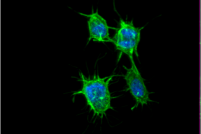We develop material-based approaches to study and elucidate how cells regulate morphogenesis via physical matrix properties in 3D culture. We use a model system premised on cell-laden hydrogel scaffolds arranged in a “gel-in-gel” configuration for studying three important agonists: matrix stiffness, ligand density, and proteolytic responsiveness
Our laboratory is developing model systems for studying important agonists in 3D cellular morphogenesis. For example, we create cell-laden microgels and arrange them in a “gel-in-gel” configuration where different cells are encapsulated in different domains, each domain having a particular formulation and composition. The gel-in-gel system, which can create unique interfaces of biochemical and biomechanical cues, is ultimately used on mesenchymal stem cells (MSCs) in 3-D culture in conjunction with techniques for quantitatively assessing the cell biology of the system. Already, these studies have begun to validate the relative importance of several matrix properties that are know agonists in cellular morphogenesis, such as matrix modulus, adhesion ligand density, proteolytic responsiveness of the matrix, and immobilized bioactive growth factors.“Gel-in-gel” model system
Much like in native tissues, individual cells within a hydrogel can be highly sensitized to external cues arising from their interactions with their extracellular matrix (ECM). Different cells often display responsiveness to both biochemical signals that are tethered to the hydrogel scaffold, as well as physical features of the polymeric network of the hydrogel. These inherent cellular sensitivities can also create a potential for adverse effects associated with sub-optimal culture environment when applying hydrogels for tissue engineering or stem cell biotechnology. At the core for the gel-in-gel culture system used to study these phenomenon is a family of stimuli-responsive biocompatible hydrogels made from adducts of fibrinogen and temperature-responsive synthetic polymers such as Tetronic and Pluronic. These hydrogels can be designed with independent control of ligand density, biodegradability, and matrix modulus – features that we hope to exploited for enhancing MSC morphogenesis in 3-D. For example, we use the combined chemical and physical cross-linking of these semi-synthetic hydrogels (in the gel-in-gel configuration) to independently control the ECM compliance and proteolysis of the culture milieu. Our ongoing work is focused on characterizing the morphogenic behavior of MSCs encapsulated in the different domains of the hydrogels, as the compliance, ligand density, biodegradability, and morphogens of the materials are altered. We look for specific correlations between the interfacial material properties and the morphogenetic behavior of the encapsulated MSCs. For this purpose, the characterization of the hydrogel scaffolds and the characterization of the morphogenetic events that precipitate following cell encapsulation are quantitatively documented using various techniques, including rheometry, morphometry, time-lapse microscopy, cell tracking, confocal immunofluorescence, cytometry, RT-PCR and cryo-SEM. These studies may further identify environmental conditions that are optimal for directing stem cells in vivo based on biophysical induction, which is essential in successfully designing scaffolds that can favorably affect the final outcome in tissue engineering.
Relevant Publications
No publications found.
